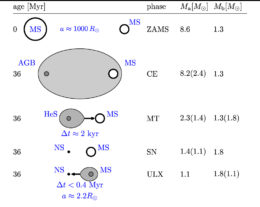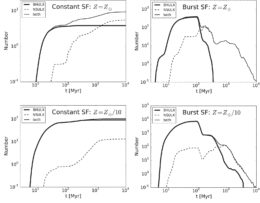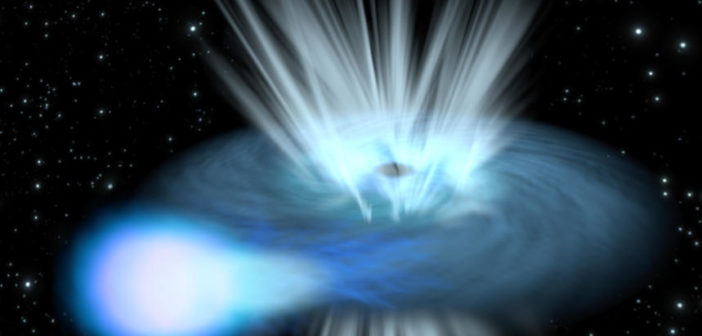Ultraluminous X-ray sources (ULXs) are astronomical sources of X-rays that, while dimmer than active galactic nuclei, are nonetheless brighter than any known stellar process. What are these beasts and why do they shine so brightly?
Exceeding the Limit
First discovered in the 1980s, ULXs are rare sources that have nonetheless been found in all types of galaxies. Though the bright X-ray radiation seems likely to be coming from compact objects accreting gas, there’s a problem with this theory: ULXs outshine the Eddington luminosity for stellar-mass compact objects. This means that a stellar-mass object couldn’t emit this much radiation isotropically without blowing itself apart.
There are two alternative explanations commonly proposed for ULXs:
- Rather than being accreting stellar-mass compact objects, they are accreting intermediate-mass black holes. A hypothetical black hole of 100 solar masses or more would have a much higher Eddington luminosity than a stellar-mass black hole, making the luminosities that we observe from ULXs feasible.
- They are ordinary X-ray binaries (a stellar-mass compact object accreting matter from a companion star), but they are undergoing a short phase of extreme accretion. During this time, their emission is beamed into jets, making them appear brighter than the Eddington luminosity.

An example of one of the common routes the authors find for a binary system to become a ULX. In this case, the binary begins as two main sequence stars. As one star evolves off the main sequence, the binary undergoes a common envelope phase and a stage of mass transfer. The star ends its life as a supernova, and the resulting neutron star then accretes matter from the main sequence star as a ULX. [Wiktorowicz et al. 2017]
Clues from a New Discovery
A few years ago, a new discovery shed some light on ULXs: M82 X-2, a pulsing ULX. Two more pulsing ULXs have been discovered since then, demonstrating that at least some ULXs contain pulsars — i.e., neutron stars — as the accreting object. This provided strong support for the second model of ULXs as X-ray binaries with super-Eddington luminosity.
But could this model in fact account for all ULXs? A team of authors led by Grzegorz Wiktorowicz (Kavli Institute for Theoretical Physics, UC Santa Barbara and Warsaw University, Poland) says yes.

Time evolution of the number of ULXs since the beginning of star formation, for a star formation burst (left panels) and continuous star formation (right panels), and for solar-metallicity (top panels) and low-metallicity (bottom panels) environments. The heavy solid line shows ULXs with black-hole accretors, the dashed line ULXs with neutron-star accretors, and the solid line the total. [Wiktorowicz et al. 2017]
No Exotic Objects Needed
Wiktorowicz and collaborators performed a massive suite of simulations — made possible by donated computer time from the Universe@Home project — to examine how 20 million binary systems evolve into X-ray binaries. They then determined the number and nature of the ones that could appear as ULXs to us. The authors’ results show that the vast majority of the observed population of ULXs can be accounted for with super-Eddington compact binaries, without needing to invoke intermediate-mass black holes.
Wiktorowicz and collaborators demonstrate that in environments with short star-formation bursts, black-hole accretors are the most common ULX source in the early periods after the burst, but neutron-star accretors dominate the ULX population after a few 100 Myr. In the case of prolonged and continuous star formation, neutron-star accretors dominate ULXs if the environment is solar metallicity, whereas black-hole accretors dominate in low-metallicity environments.
The authors’ results present very clear and testable relations between the companion and donor star evolutionary stage and the age of the system, which we will hopefully be able to use to test this model with future observations of ULXs.
Citation
Grzegorz Wiktorowicz et al 2017 ApJ 846 17. doi:10.3847/1538-4357/aa821d


1 Comment
Pingback: Universe@home zauważone na arenie międzynarodowej. - BOINC@Poland